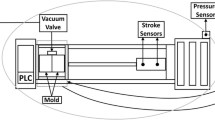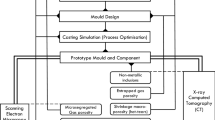Abstract
Defects in investment casting will inevitably reduce the lifetime, degrade the quality of the casting, and increase the manufacturing costs. In this paper, the potential for shrinkage porosity was numerically determined and a retained melt modulus (RMM) model was implemented to analyze highly probable regions. The proposed casting schemes of gating designs are compared by the quality of casting (shrinkage porosity) and practical feasibility in terms of small hole drilling machinability. The purpose of this study was to determine the feasible plan with the lowest PES (percentage of elements with shrinkage porosity) while promoting near-net shape casting with minimum machining cost and increasing material usage. Virtual thermo-dynamical sensors (VTDSs) were adopted in the simulations to indicate the impacts of different pattern assembly gating systems on the cooling gradient and direction of solidification. VTDSs were used in simulating and virtually monitoring the casting systems, with the aim of characterizing the rates and directions of solidification in various regions of the cast. The best-case scenario of investment casting conditions was chosen to fabricate valve housing in an investment casting foundry. The experimental results of the X-ray image differentiated nearly none of the pernicious defects that typically occurred with the proposed casting, confirming the efficacy of the proposed scheme accordingly.





















Similar content being viewed by others
Data Availability
The authors confirm that the data supporting the findings of this study are available within the article.
References
Y. Fang, J. Hu, J. Zhou et al., Numerical simulation of filling and solidification in exhaust manifold investment casting. Inter Metalcast 8, 39–45 (2014). https://doi.org/10.1007/BF03355593
P.H. Huang, K.L. Shih, H.M. Lin, C.I. Chu, C.S. Chou, Novel approach to investment casting of heat-resistant steel turbine blades for aircraft engines. Int J Adv Manuf Technol 104, 2911–2923 (2019)
X.H. Zhi, Y.J. Han, X.M. Yuan, Casting process optimization for the impellor of 200ZJA slurry pump. Int J Adv Manuf Technol 77, 1703–1710 (2015)
P.H. Huang, B.T. Wang, Y.T. Chen, An effective method for separating casting components from the runner system using vibration-induced fatigue damage. Int J Adv Manuf Technol 74, 1275–1282 (2014)
Y.H. Hou, Z.Q. Cheng, W.C. Feng, B.S. Liu, Using Procast to forecast and analysis of the shrinkage porosity and its technical optimization swaminathan. China Water Transport 7(3), 67–69 (2007)
P.H. Huang, W.J. Wu, C.H. Shieh, Compute-aided design of low pressure die-casting process ofA356 aluminum wheels. ApplMech Mater 864, 173–178 (2016)
Y.W. Dong, X.L. Li, Q. Zhao, J. Yang, M. Dao, Modeling of shrinkage during investment casting of thin-walled hollow turbine blades. J Mater Process Technol 244, 190–203 (2017)
P.H. Wang, J.P. Sun, A.P. Dong, D. Shu, G.L. Zhu, B.D. Sun, An optimization method of gating system for impeller by RSM and simulation in investment casting. Int J Adv Manuf Tech 98, 3105–3114 (2018)
P.H. Huang, C.Y. Cheng, W.J. Huang, CSh. Chou, Optimal design of investment casting system for toothed chain joint: computer simulations and experimental verification. Int J Adv Manuf Technol 106, 1931–1943 (2020)
J.K. Kuo, P.H. Huang, H.Y. Lai, J.R. Chen, Optimal gating system design for investment casting of 17–4PH stainless steel enclosed impeller by numerical simulation and experimental verification. Int J Adv Manuf Technol 92, 1093–1103 (2017)
M. Wu, M. Augthun, Application of laser measuring, numerical simulation and rapid prototyping to titanium dental castings. Dent Mater 17, 102–108 (2001)
J.K. Kuo, P.H. Huang, M.J. Guo, Removal of CrMo alloy steel components from investment casting gating system using vibration excited fatigue failure. Int J Adv Manuf Technol 89, 101–111 (2017)
Z.H. Wang, J. Wang, L.B. Yu et al., Numerical simulation and process optimization of vacuum investment casting for Be–Al alloys. Inter Metalcast 13, 74–81 (2019). https://doi.org/10.1007/s40962-018-0228-1
D.Z. Li, J. Campbell, Y.Y. Li, Filling system for investment cast Ni-base turbine blades. J Mater Process Technol 148, 310–316 (2004)
B.H. Hu, K.K. Tong, X.P. Niu, I. Pinwill, Design and optimization of runner and gating systems for the die casting of thin-walled magnesium telecommunication parts through numerical simulation. J Mater Process Technol 105, 128–133 (2000)
X.P. Zhang, G. Chen, Computer simulation of the solidification of cast titanium dental prostheses. J Mater Sci 40, 4911–4916 (2005)
H.J. Kwon, H.K. Kwon, Computer aided engineering (CAE) simulation for the design optimization of gate system on high pressure die casting (HPDC) process. Robot Comput Integr Manuf 55, 147–153 (2019)
E.S. Kim, J.Y. Park, Y.H. Kim, K.H. Lee, Evaluation of diecasting mold cooling ability by decompression cooling system. J. Korea Foundry Soc 29, 238–243 (2009)
M. Xu, S.N. Lekakh, V.L. Richards, Thermal property database for investment casting shells. Inter Metalcast 10, 329–337 (2016). https://doi.org/10.1007/s40962-016-0052-4
J.Q. Wang, P.X. Fu, H.G. Liu, D.Z. Li, Y.Y. Li, Shrinkage porosity criteria and optimized design of a 100-ton 30Cr2Ni4MoV forging ingot. Mater. Des. 35, 446–456 (2012)
A. Sata, B. Ravi, Bayesian inference-based investment casting defect analysis system for industrial application. Int J Adv Manuf Technol 90, 3301–3315 (2017)
R.A. Hardin, K.K. Choi, N.J. Gaul, C. Beckermann, Reliability based casting process design optimization. Int J Cast Met Res 28(3), 181–192 (2015)
J.K. Kuo, P.H. Huang, H.Y. Lai, W.J. Wu, Design of casting systems for stainless steel exhaust manifold based on defective prediction model and experimental verification. Int J Adv Manuf Technol. (2018). https://doi.org/10.1007/s00170-018-2737-8
K. Bu, Research on the influence of structure parameters on the fractional shrinkage of wheel shape casting. Int J Adv Manuf Technol 93, 3933–2942 (2017)
J. Jin, C.H. Liu, X.M. Lai, F. Li, B. He, Bayesian network approach for ceramic shell deformation fault diagnosis in the investment casting process. Int J Adv Manuf Technol 88, 663–674 (2017)
J.W. Woolley, K.A. Woodbury, The interfacial heat transfer coefficient of metal castings—a literature review. AFS Trans. 115, 1–18 (2007)
M. Chiumenti, C. Agelet de Saracibar, M. Cervera, On the numerical modeling of the thermomechanical contact for metal casting analysis. J. Heat Transf. 130(6), 061301 (2008). https://doi.org/10.1115/1.2897923
Funding
This research was supported by the project funded by GlobalTek Fabrication Co., Ltd. in cooperation with the National Central University.
Author information
Authors and Affiliations
Contributions
All authors contributed equally to the generation and analysis of experimental data, and the development of the manuscript.
Corresponding author
Ethics declarations
Conflict of interest
Author declare that they have no financial and personal relationships with other people or organizations that can inappropriately influence our work; there is no professional or other personal interest of any nature or kind in any product, service, and/or company that could be construed as influencing the position presented in, or the review of, the manuscript entitled.
Ethics Approval
This article does not contain any studies with human participants or animals performed by any of the authors.
Consent to Participate
All authors declare they have agreed for authorship, have read and approved the manuscript, and have given the consent for submission and subsequent publication of the manuscript.
Consent for Publication
All authors are consenting to publish this article with its included data in The International Journal of Advanced Manufacturing Technology and approve its final version.
Additional information
Publisher's Note
Springer Nature remains neutral with regard to jurisdictional claims in published maps and institutional affiliations.
Rights and permissions
About this article
Cite this article
Kao, Y.C., Ho, MH., Tseng, H.W. et al. Computer-Aided Engineering (CAE) Simulation for the Robust Gating System Design: Improved Process for Investment Casting Defects of 316L Stainless Steel Valve Housing. Inter Metalcast 16, 2014–2032 (2022). https://doi.org/10.1007/s40962-021-00733-1
Received:
Accepted:
Published:
Issue Date:
DOI: https://doi.org/10.1007/s40962-021-00733-1




